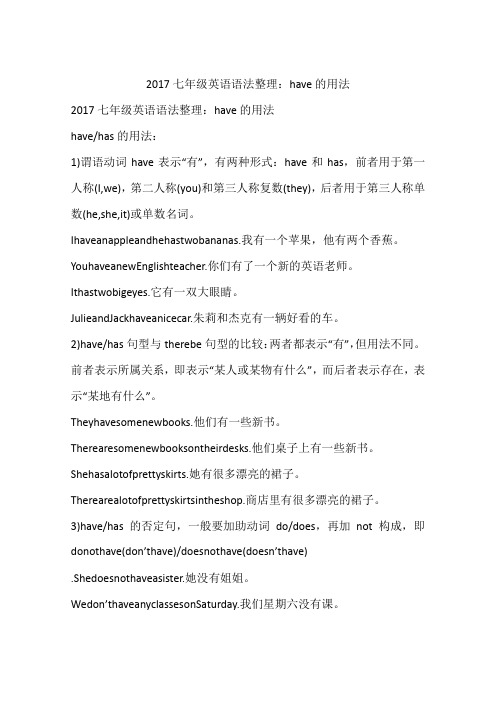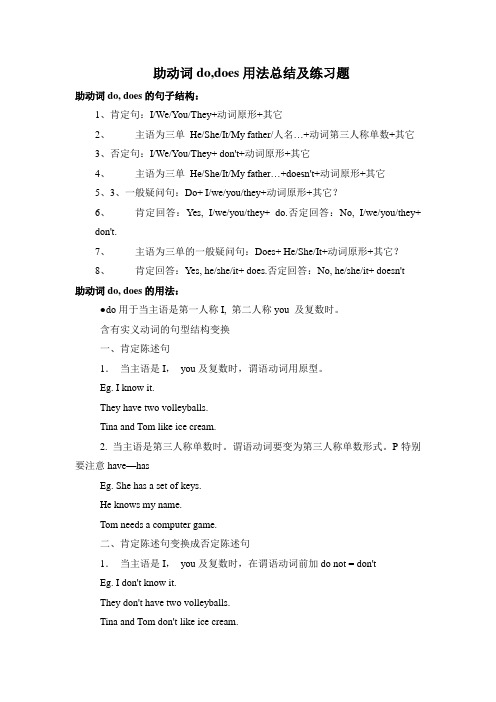七年级have-has-do-does的用法与练习题
17、have_has的用法与练习题

have/has专项训练 have/has的用法①作“有”讲时,强调“所属关系”,表示“拥有”的意思。
其主语常为人或物。
如: My father has many new books.我爸爸有许多新书。
I have a new computer.我有一台新电脑。
②“have+表示一日三餐的名词”,意为“用餐”。
如:have breakfast/lunch/supper吃早饭/午饭/晚饭。
③“have+表示食品、饮料等名词”,意为“吃;喝”。
如:have bread吃面包 have eggs 吃鸡蛋 have tea 喝(一杯)茶。
④“have+表示动作的名词”,没有固定的意思,常与表示动作的名词同义。
如: have a rest 休息一下 have a swim 游泳 have a drink (of...)喝一点(……) have a look (at ...)(朝……)看一眼⑤“have+表示某种活动的名词”,意为“进行,举行”。
如:如: have a class (学生) 上课 have a birthday party 举行生日聚会一.填写正确的形式。
1.I ____ (have) a cat.2.He ____ (have) a dog.3.She ____ (have) long hair.4.We ____ (have) a big house.5.They ____ (have) a happy family.6.It ____ (have) a short tail.7.You ____ (have) a good teacher.8.Elva ____ (have) two big eyes.9.Tom ____ (have) a red pen.10.My mother ____ (have) a beautiful nose. 11.Cats ____ (have) four legs.12.Dogs ____ (have) two ears.13.My father ____ (have) a blue car.14.Everybody ____ (have) two hands.15.I ____ (have) a model plane.16.Lily ____ (have) a doll.17.Students ____ (have) many books.18.Girls ____ (have) many skirts.19.The baby ____ (have) no teeth.20.They ____ (have) some fish.二.Fill in the blank with “ have, has ”1. I_________ a nice puppet.2. He_________a good friend.3. They__________ some masks.4. We___________some flowers.5. She___________ a duck.6. My father____________ a new bike.7. Her mother___________a vase.8. Our teacher_________ an English book.9. Our teachers___________a basketball.10. Their parents___________some blankets 11. Nancy_________many skirts.12. David__________some jackets.13. My friends__________a football.14. What do you__________?15. What does Mike__________?16. What do your friends___________?17. What does Helen___________?18. His brother________a basketball.19. Her sister_________a nice doll.20. Miss Li__________an English book.三.下面我们做一些练习来巩固一下:①根据汉语提示完成句子,使句意完整。
have,has的用法

have,has的用法have和has是英语中常见的动词,它们表示"拥有"或者"持有"的意思。
这两个词根据主语的人称和数的不同形式有所变化:have用于第一、第二以及第三人称复数主语(I, you, we, they),以及第二人称单数主语(you),而has则用于第三人称单数主语(he, she, it)。
一、have和has的肯定句用法1. 拥有物体:have/has + 名词例如:- I have a car.(我有一辆车。
)- She has a cat. (她有一只猫。
)- They have two dogs. (他们有两只狗。
)2. 拥有特征、感觉或状态:have/has + 形容词例如:- We have a big house. (我们有一所大房子。
)- He has a lovely smile. (他有一个可爱的笑容。
)- She has a sore throat. (她喉咙痛。
)3. 持有某种位置: have/has + 介词短语例如:- They have a picnic in the park. (他们在公园里野餐。
)- He has a meeting at 2 p.m. (他下午两点有个会议。
)二、have和has的否定句用法1. 在肯定句中加入否定词not构成否定句例如:- I do not have a car. (我没有汽车。
)- She does not have a cat. (她没有猫。
)- They do not have two dogs. (他们没有两只狗。
)2. 在肯定句的缩略形式中,常用haven't 和 hasn't例如:- I haven't seen him today. (我今天还没见到他。
)- She hasn't finished her homework. (她还没有做完作业。
have has,do does 的用法

一、用词的适当形式填空。
1.Nancy _____(have)two big eyes.2._____ (do) your brother have an animal friend?肯定回答:___________________否定回答:____________________3.They ______(have) no legs or arms.4._____(do) Helen have a dog?5.My cats ______(have) long tails.6.His cousin _____(have) some toy cars.7.LiuTao and Mike _____(have) two animal friends.8._____(do) you have _____ (some) toy cars?9.It ____ four legs and a short tail.10._____(do) Lily _____(have) any milk ?11.Yang Ling doesn’t ______ (have) any books.12.______ (do) Liu tao and Mike like Maths?肯定回答:___________________否定回答:____________________13.Goldilocks ______(have) a nice dress.14.He _____ (have) a lot of pencils.15._______ (do) you have an English lesson on Monday morning?二.选词填空。
1. There are five (fish,fishes) in the water.2. Helen (have, has) a watch.3. Can you (dance, dancing)?4. It (have, has) long hair and big (eye, eyes).5. --What (does, do) she (have, has)? --She (have, has) a cat.6. Jack and Tom (don’t have, doesn’t has) a toy car.7. I can’t find ______________(his, him).8. The girl can dance, but the boy ___________ (can, can’t).9. There __________ (aren’t, are) any apples in the basket.10. —_____________(Where’s, What’s) on the bed? —There’s a doll on it.。
2017七年级英语语法整理:have的用法

2017七年级英语语法整理:have的用法2017七年级英语语法整理:have的用法have/has的用法:1)谓语动词have表示“有”,有两种形式:have和has,前者用于第一人称(I,we),第二人称(you)和第三人称复数(they),后者用于第三人称单数(he,she,it)或单数名词。
Ihaveanappleandhehastwobananas.我有一个苹果,他有两个香蕉。
YouhaveanewEnglishteacher.你们有了一个新的英语老师。
Ithastwobigeyes.它有一双大眼睛。
JulieandJackhaveanicecar.朱莉和杰克有一辆好看的车。
2)have/has句型与therebe句型的比较:两者都表示“有”,但用法不同。
前者表示所属关系,即表示“某人或某物有什么”,而后者表示存在,表示“某地有什么”。
Theyhavesomenewbooks.他们有一些新书。
Therearesomenewbooksontheirdesks.他们桌子上有一些新书。
Shehasalotofprettyskirts.她有很多漂亮的裙子。
Therearealotofprettyskirtsintheshop.商店里有很多漂亮的裙子。
3)have/has的否定句,一般要加助动词do/does,再加not构成,即donothave(don’thave)/doesnothave(doesn’thave).Shedoesnothaveasister.她没有姐姐。
Wedon’thaveanyclassesonSaturday.我们星期六没有课。
AnnandIdon’thaveabigroom.我和安没有一个大房间。
4)一般疑问句由“助动词Do/Does+主语+have+宾语”构成,回答用Yes,…do/does.或者No,…don’t/doesn’t.--Doyouhaveabighouse?他们的房子大吗?--No,theydon’t.不,他们的房子不大。
have_has_do_does的用法与练习题知识分享

h a v e_h a s_d o_d o e s的用法与练习题have/has专项训练姓名________________①作“有”讲时,强调“所属关系”,表示“拥有”的意思。
其主语常为人或物。
如:My father has many new books.我爸爸有许多新书。
I have a new computer.我有一台新电脑。
②“have+表示一日三餐的名词”,意为“用餐”。
如:have breakfast/lunch/supper吃早饭/午饭/晚饭。
③“have+表示食品、饮料等名词”,意为“吃;喝”。
如:have bread吃面包 have eggs 吃鸡蛋 have tea 喝(一杯)茶。
④“have+表示动作的名词”,没有固定的意思,常与表示动作的名词同义。
如:have a rest 休息一下have a swim 游泳 have a drink (of...)喝一点(……)have a look (at ...)(朝……)看一眼⑤“have+表示某种活动的名词”,意为“进行,举行”。
如:如:have a class (学生) 上课have a birthday party 举行生日聚会一.填写正确的形式。
1.I ____ (have) a cat.2.He ____ (have) a dog.3.She ____ (have) long hair.4.We ____ (have) a big house.5.They ____ (have) a happy family.6.It ____ (have) a short neck.7.You ____ (have) a good teacher.8.Elva ____ (have) two big eyes.9.Tom ____ (have) a red pen.10.My mother ____ (have) a small nose. 11.Cats ____ (have) four legs.12.Dogs ____ (have) two ears.13.My father ____ (have) a blue car.14.Everybody ____ (have) two hands.15.I ____ (have) a cat.16.Lily ____ (have) a toy.17.Students ____ (have) many books.18.Girls ____ (have) nine books.19.The baby ____ (have) two teeth.20.They ____ (have) some apples.二.Fill in the blank with “ have, has ”1. I_________ a nice puppet.2. He_________a good friend.3. They__________ some masks.4. We___________some flowers.5. She___________ a duck.6. My father____________ a new bike.7. Her mother___________a vase.8. Our teacher_________ an English book.9. Our teachers___________a basketball.10. Their parents___________someblankets 11. Nancy_________many skirts.12. David__________some jackets.13. My friends__________a football.14. What do you__________?15. What does Mike__________?16. What do your friends___________?17. What does Helen___________?18. His brother________a basketball.19. Her sister_________a nice doll.20. Miss Li__________an English book.三.下面我们做一些练习来巩固一下:do/does专项训练姓名________________ 分数________________①作为行为动词,表示“做”如:I always do housework. 我经常做家务。
人教新目标 七年级上册 英语 助动词do,does用法总结及练习题(无答案)

助动词do,does用法总结及练习题助动词do, does的句子结构:1、肯定句:I/We/You/They+动词原形+其它2、主语为三单He/She/It/My father/人名…+动词第三人称单数+其它3、否定句:I/We/You/They+ don't+动词原形+其它4、主语为三单He/She/It/My father…+doesn't+动词原形+其它5、3、一般疑问句:Do+ I/we/you/they+动词原形+其它?6、肯定回答:Yes, I/we/you/they+ do.否定回答:No, I/we/you/they+don't.7、主语为三单的一般疑问句:Does+ He/She/It+动词原形+其它?8、肯定回答:Yes, he/she/it+ does.否定回答:No, he/she/it+ doesn't助动词do, does的用法:●do用于当主语是第一人称I, 第二人称you 及复数时。
含有实义动词的句型结构变换一、肯定陈述句1.当主语是I,you及复数时,谓语动词用原型。
Eg. I know it.They have two volleyballs.Tina and Tom like ice cream.2. 当主语是第三人称单数时。
谓语动词要变为第三人称单数形式。
P特别要注意have—hasEg. She has a set of keys.He knows my name.Tom needs a computer game.二、肯定陈述句变换成否定陈述句1.当主语是I,you及复数时,在谓语动词前加do not = don'tEg. I don't know it.They don't have two volleyballs.Tina and Tom don't like ice cream.2. 当主语是第三人称单数时,在谓语动词前加does not = doesn't, 谓语动词打回原型Eg. She doesn't have a set of keys.He doesn't know my name.Tom doesn't need a computer game.三、肯定陈述句变换成一般疑问句采用“一加二变三问号”。
have-has-do-does的用法与练习题

have/has专项训练 ________________①作“有”讲时,强调“所属关系”,表示“拥有”的意思。
其主语常为人或物。
如:My father has many new books.我爸爸有许多新书。
I have a new computer.我有一台新电脑。
②“have+表示一日三餐的名词”,意为“用餐”。
如:have breakfast/lunch/supper吃早饭/午饭/晚饭。
③“have+表示食品、饮料等名词”,意为“吃;喝”。
如:have bread吃面包 have eggs 吃鸡蛋 have tea 喝(一杯)茶。
④“have+表示动作的名词”,没有固定的意思,常与表示动作的名词同义。
如:have a rest 休息一下 have a swim 游泳 have a drink (of...)喝一点(……) have a look (at ...)(朝……)看一眼⑤“have+表示某种活动的名词”,意为“进行,举行”。
如:如:have a class (学生) 上课have a birthday party 举行生日聚会一.填写正确的形式。
1.I ____ (have) a cat.2.He ____ (have) a dog.3.She ____ (have) long hair.4.We ____ (have) a big house.5.They ____ (have) a happy family.6.It ____ (have) a short neck.7.You ____ (have) a good teacher.8.Elva ____ (have) two big eyes.9.Tom ____ (have) a red pen.10.My mother ____ (have) a small nose. 11.Cats ____ (have) four legs.12.Dogs ____ (have) two ears.13.My father ____ (have) a blue car.14.Everybody ____ (have) two hands.15.I ____ (have) a cat.16.Lily ____ (have) a toy.17.Students ____ (have) many books.18.Girls ____ (have) nine books.19.The baby ____ (have) two teeth.20.They ____ (have) some apples.二.Fill in the blank with “ have, has ”1. I_________ a nice puppet.2. He_________a good friend.3. They__________ some masks.4. We___________some flowers.5. She___________ a duck.6. My father____________ a new bike.7. Her mother___________a vase.8. Our teacher_________ an English book.9. Our teachers___________a basketball.10. Their parents___________some blankets 11. Nancy_________many skirts.12. David__________some jackets.13. My friends__________a football.14. What do you__________?15. What does Mike__________?16. What do your friends___________?17. What does Helen___________?18. His brother________a basketball.19. Her sister_________a nice doll.20. Miss Li__________an English book.三.下面我们做一些练习来巩固一下:①根据汉语提示完成句子,使句意完整。
have和has的用法讲解及练习

1. has 用于第三人称单数(she, he, it 或 单数名词)
he
she has 主语为第三人称
it
单数时用has,
其余人称都用have。 I
we you
have
they
2. have 用于第一人称单数(I, we),第二 人称(you)以及第三人称复数(they或其他 复数名词、并列的主语等)
A
bird(鸟)hastwo
legs.
2. Our (我们的)school hasa library(图书馆).
3. Wehave37 chairs(椅子) in our classroom(教室). 4. Ithas many (许多) books in it. 5. My sisterhas a nice toy car.
用have 和has填空。
have
1.I __h_a_sgot a cat.
2.He _h_a_s_ got a dog. 3.She ____ got a nice pencil. 4.Weh_a_v_e_ got a big house(房子).
5.Theyh_a_v_e_ got a happy family(家庭).
12. Janehastwo big eyes.
13. Tom has a red pen. 14. Their(他们的) teacherhas some nice books. 15. Your teachers have a football(足球). 16. Jenny and Danny _h_a_v_e__two pens. 17. Youhavea good teacher. 18. Li Ming’s mother(妈妈) _h_a_s__two big eyes.
- 1、下载文档前请自行甄别文档内容的完整性,平台不提供额外的编辑、内容补充、找答案等附加服务。
- 2、"仅部分预览"的文档,不可在线预览部分如存在完整性等问题,可反馈申请退款(可完整预览的文档不适用该条件!)。
- 3、如文档侵犯您的权益,请联系客服反馈,我们会尽快为您处理(人工客服工作时间:9:00-18:30)。
七年级英语专项练习have/has 的用法①作“有”讲时,强调“所属关系”,表示“拥有”的意思。
其主语常为人或物。
如:My father has many new books.我爸爸有许多新书。
I have a new computer.我有一台新电脑。
②“have+表示一日三餐的名词”,意为“用餐”。
如:have breakfast/lunch/supper吃早饭/午饭/晚饭。
③“have+表示食品、饮料等名词”,意为“吃;喝”。
如:have bread吃面包 have eggs 吃鸡蛋 have tea 喝(一杯)茶。
④“have+表示动作的名词”,没有固定的意思,常与表示动作的名词同义。
如:have a rest 休息一下 have a swim 游泳 have a drink (of...)喝一点(……) have a look (at ...)(朝……)看一眼⑤“have+表示某种活动的名词”,意为“进行,举行”。
如:如:have a class (学生) 上课have a birthday party 举行生日聚会一.填写正确的形式。
1.I ____ (have) a cat.2.He ____ (have) a dog.3.She ____ (have) long hair.4.We ____ (have) a big house.5.They ____ (have) a happy family.6.It ____ (have) a short neck.7.You ____ (have) a good teacher.8.Elva ____ (have) two big eyes.9.Tom ____ (have) a red pen.10.My mother ____ (have) a small nose. 11.Cats ____ (have) four legs.12.Dogs ____ (have) two ears.13.My father ____ (have) a blue car.14.Everybody ____ (have) two hands.15.I ____ (have) a cat.16.Lily ____ (have) a toy.17.Students ____ (have) many books.18.Girls ____ (have) nine books.19.The baby ____ (have) two teeth.20.They ____ (have) some apples二.Fill in the blank with “ have, has ”1. I_________ a nice puppet.2. He_________a good friend.3. They__________ some masks.4. We___________some flowers.5. She___________ a duck.6. My father____________ a new bike.7. Her mother___________a vase.8. Our teacher_________ an English book.9. Our teachers___________a basketball.10. Their parents___________some blankets 11. Nancy_________many skirts.12. David__________some jackets.13. My friends__________a football.14. What do you__________?15. What does Mike__________?16. What do your friends___________?17. What does Helen___________?18. His brother________a basketball.19. Her sister_________a nice doll.20. Miss Li__________an English book.三.下面我们做一些练习来巩固一下:七年级上册英语do/does专项训练①作为行为动词,表示“做”如:I always do housework. 我经常做家务。
She usually does homework in the afternoon. 她通常在下午做作业。
②作为助动词,帮助主要动词构成否定和疑问。
(do/does的否定为don’t/doesn’t)如:We don’t like bananas.Do you like apples? Does he like English?He doesn’t like swimming.一.填写正确的否定形式(don’t/doesn’t)。
1.I ____ have a cat.2.He ____ like dogs..3.She ____ have a long hair.4.We ____ have a big house.5.They ____ have a happy family.6.It ____ have a short tail.7.You ____ like a good teacher.8.Elva ____ like a bad girl.9.Tom ____ have a red pen. 10.My mother ____ have a beautiful nose.11.Cats ____ have two legs.12.Dogs ____ have one ears.13.My father ____ have a blue car.14.Everybody ____ have two hands.15.I ____like a model plane.16.Lily ____ like a toy.17.Students ____ have many books.18.Girls ____ have many skirts.19.The baby ____ have no tooth. 20.They ____ have some fish.二.将下列句子变为否定句。
1. I want to go home now. ____________________________________2. She likes eating apples very much. ____________________________________3. He likes this coat. ____________________________________4. They have a lot of friends. ____________________________________5. She wants to be a doctor. ____________________________________6. He has a dream. ____________________________________可数名词单数变复数规则及练习名词可以分为可数名词与不可数名词。
其中可数名词具有单复数的形式;而不可数名词没有复数形式。
可数名词复数变化规则如下:1.一般情况下,直接加-s,如:book-books, bag-bags, cat-cats, bed-beds2.以s. x. sh. ch结尾,加-es,读作【iz】。
如:bus-buses, box-boxes, watch-watches,brush-brushes3.以“辅音字母+y”结尾,变y为i, 再加-es,如:family-families,strawberry-strawberries练习:library dictionary4.以“f或fe”结尾,变f或fe为v, 再加-es,如:knife-knives,thief-thieves练习:wolf wife5. 以o结尾,记住hero-heroes, tomato-tomatoes, potato-potatoes加es(英雄爱吃西红柿和土豆)不规则名词复数变化:man-men, woman-women, policeman-policemen, policewoman-policewomen, mouse-mice, child-children, foot-feet, tooth-teeth以下名词单复数相同fish-fish, sheep-sheep, deer-deer以下词为不可数名词。
water(水) milk(牛奶) tea(茶) rice(米饭) orange(橙汁)juice(果汁)bread(面包)不可数名词的数量关系可借助量词表示,如:a cup of tea, two cups of tea名词复数练习题1).填入所给名词的正确形式1. I have two_____ (knife)2. There are many _____ here. (box)3. There are many _____ on the road. (bus)4. A few _____ are drawing on the wall. (boy)5. The _____ are playing football now. (child)2)选择填空1. They come from different ______A. countryB. countriesC. a countryD. countrys2. How many ______ do you see in the picture?A. tomatosB. tomatoesC. tomatoD. the tomato3. There are some ______ in these _______.A. knifes…pencil-boxesB. knives…pencils-boxC. knives…pencil-boxesD. knives…pencils-boxes4. There is no ______ in the plate.A. applesB. orangesC. riceD. eggs5. _______ are good for our health.A. TomatosB. TomatoesC. Tomato6. I like to eat cake with ______.A. cherriesB. cherryC.cherrys7. ______ and ______ are not friends.A. Foxs wolfsB. Foxes wolfsC. Foxes wolves8. Do you want to drink much ?A、a milkB、milkC、milks9. This is room. It’s very big.A、Lily and Lucy’sB、Lily’s and Lucy’sC、Lily’s and Lucy10. Do you want some for supper?A、a potatoB、potatoesC、potatos11. In autumn,you can see a lot of on the ground.A、leafB、leafsC、leaves12. My sister has two . One is old,the other is new.A、a watchB、watchsC、watches13.There on the wall .They are very beautiful.A. are photoesB. are photosC. is a photoD. is photos14. That’s art book.A. anB. aC. the D are15. There two in the box.A. is watchB. are watchesC. are watchD. is watches 3)请用括号中名词的复数形式填空1. Look at those _______. (child)2. I can see a __________ standing near the door. (policeman)3. Do you want some ________ for dinner? (potato)4. In autumn, you can see a lot of _______ on the ground.(leaf)5. He has two _______.One is blue , the other is yellow.( box)6. Two ________ live in this building .( family )4)选择正确的词形1. How many (radioes, radios) can you see?2. There are 36 (boys, boies) in my class.3. Look at those (sheeps, sheep).4.I don’t want (a, an) old cup.5. Give me that (box, boxes), please.5)将以下单复数句进行转换1. This is a knife. ______________________________2. That is a tomato. ______________________________3. That child is very good.____________________________4 . These are mice. ____________________________ 5. Those are children. _____________________________。
